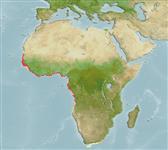Common names from other countries
Environment: milieu / climate zone / depth range / distribution range
Écologie
; profondeur 1 - 55 m (Ref. 435), usually 10 - 30 m (Ref. 435). Tropical; 20°N - 17°S
Distribution
Pays | Zones FAO | Écosystèmes | Occurrences | Introductions
Eastern Atlantic: from Mauritania to Angola.
Length at first maturity / Taille / Poids / Âge
Maturity: Lm ? range ? - ? cm Max length : 9.3 cm CL mâle / non sexé; (Ref. 435)
Maximum carapace width: 19.0 cm (Ref. 435). Also caught by trammel nets (Ref. 417). Occurs at depths from 1 to 55 m, common at depths of 10 to 30 m. Inhabits shallow coastal waters with bottoms consisting of sand or mud (Ref. 435).
Life cycle and mating behavior
Maturité | Reproduction | Frai | Œufs | Fécondité | Larves
Members of the order Decapoda are mostly gonochoric. Mating behavior: Precopulatory courtship ritual is common (through olfactory and tactile cues); usually indirect sperm transfer.
Fischer, W., G. Bianchi and W.B. Scott (eds.). 1981. (Ref. 435)
Statut dans la liste rouge de l'IUCN (Ref. 130435)
statut CITES (Ref. 108899)
Not Evaluated
Not Evaluated
Menace pour l'homme
Harmless
Utilisations par l'homme
Pêcheries: commercial
| FishSource |
Outils
Sources Internet
Estimates based on models
Preferred temperature
(Ref.
115969): 22.7 - 28, mean 26.6 (based on 50 cells).
Vulnérabilité
Low vulnerability (10 of 100).
